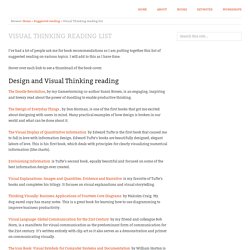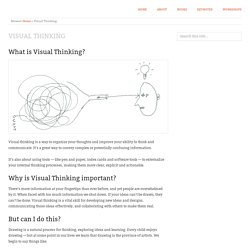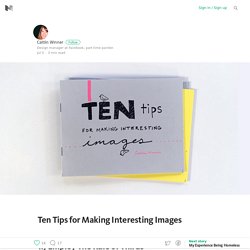

Visual Thinking reading list. I’ve had a lot of people ask me for book recommendations so I am putting together this list of suggested reading on various topics.

I will add to this as I have time. Hover over each link to see a thumbnail of the book cover. The Doodle Revolution, by my Gamestorming co-author Sunni Brown, is an engaging, inspiring and breezy read about the power of doodling to enable productive thinking. The Design of Everyday Things , by Don Norman, is one of the first books that got me excited about designing with users in mind. The Visual Display of Quantitative Information by Edward Tufte is the first book that caused me to fall in love with Information Design. Envisioning Information is Tufte’s second book, equally beautiful and focused on some of the best information design ever created. Visual Explanations: Images and Quantities, Evidence and Narrative is my favorite of Tufte’s books and completes his trilogy. Thinking Visually: Business Applications of Fourteen Core Diagrams by Malcolm Craig. Easily Convert Bitmap Images To Clean Vector Art - Vector Magic.
The Doodle Institute. Visual Thinking. What is Visual Thinking?

Visual thinking is a way to organize your thoughts and improve your ability to think and communicate. It’s a great way to convey complex or potentially confusing information. It’s also about using tools — like pen and paper, index cards and software tools — to externalize your internal thinking processes, making them more clear, explicit and actionable. Why is Visual Thinking important? There’s more information at your fingertips than ever before, and yet people are overwhelmed by it. But can I do this? Drawing is a natural process for thinking, exploring ideas and learning. “I’m no artist” “I can’t draw a straight line” “I can’t draw a stick figure” This is a fallacy.
Don’t believe me? Visual Thinking basics In this 20-minute video I share some basics of visual thinking that will get you up and running in about 20 minutes. How to know what to draw. Ten Tips for Making Interesting Images. Ten Tips for Making Interesting Images 1.)

Employ The Rule of Thirds Images are more interesting if the interesting bits are not in the center. Unconsciously, we want to put the thing of interest in the center. But it’s more interesting if we don’t. 2.) Small things and big things are often more interesting together than all small things or all big things. 3.) Similarly, if you want to make a far away scene more interesting, try including an object in the foreground. 4.) All we see, in the end, is light and a strong light source is often interesting in and of itself. 5.) The eye has more to look at when we use different marks (or textures) in an image. 6.) Three is better than four and five is better than six. 7.)
Be aware of your subject(s) in relation to the edges of the frame, canvas or screen. 8.) Complementary colors, (colors on opposite sides of the color wheel) are exciting together. Warm and cool also make for interesting color relationships. 9.) Pay attention to what excites you. Lingo. Learn the basics with pen and paper. Do you want to have amazing and beautiful notebooks?

Do you wish that you could sometimes get away from the screen and do actual work in your notebook without interruptions? This class is for you. Digital tools like iPhones, laptops and email are amazing for many things. But for thinking big and capturing beautiful visions and ideas, without constant interruptions, nothing beats a good notebook and pen. In this class you will learn the absolutely essential skills that I use in almost everything in my life. I recommend that you complete the first two modules right away. Module 1 — Introduction Module 2 — Tools Module 3 — Getting started Module 4 — Legible handwriting Module 5 — Basic drawing Module 6 — Visual resume Module 7 — Tips & tricks Module 8 — Build a habit Module 9 — Example notebook.
Learn to solve any problem with a simple picture. Drawspace: Now everyone can draw.